Abstract
Pacific herring (Clupea pallasii Valenciennes, 1847) is a commercially important species that inhabits the coastal waters of the North Pacific from Korea to California, USA. This study analyzed the target strength (TS; dB re 1 m2) of Pacific herring individuals (n = 14, total length (LT) = 21.3–32.3 cm) at 38 and 120 kHz using ex-situ measurements and the Kirchhoff-ray mode (KRM) model. The least-squares regressions of the TS–LT relationship for the ex-situ measurements were TS38kHz = 20 log10(LT) − 70.10 (r = 0.17) and TS120kHz = 20 log10(LT) − 70.59 (r = 0.10). The least-squares regressions for the KRM model were TS38kHz = 20 log10(LT) − 68.39 (r = 0.40) and TS120kHz = 20 log10(LT) − 69.74 (r = 0.49). The b20 value of the KRM model was 1.71 dB higher than that of the ex-situ measurement at 38 kHz but similar at 120 kHz. These results provide basic data to evaluate the distribution and abundance of Pacific herring using fisheries’ acoustic technology.
1. Introduction
Pacific herring (Clupea pallasii Valenciennes, 1847), a fish in the family Clupeidae of the order Clupeiformes, is widely distributed in the North Pacific [,,]. The distribution patterns showed that herrings characteristically form dense, round, or tall pelagic schools. The schools are typically small in size during summer and form a consistent, dense layer associated with the bottom in submarine gullies during winter []. It is an economically important fishery resource, especially in the northern latitudes of Korea and Japan [,]. The maximum catch of Pacific herring in South Korea in 2008 was approximately 45,000 tons, but this decreased to 25,000 tons in 2011 []. Records indicate fluctuations in herring catchment and variability in fishery productivity; thus, a reasonable approach to manage and evaluate the status of the stock of Pacific herring is required for the sustainable use of this resource.
Acoustic surveys using scientific echosounders can rapidly provide quantitative data and have been used for fish stock assessment []. The volume backscattering strength (SV; dB re 1 m−1) can be obtained via acoustic surveys, but its conversion into abundance levels requires information on the target strength (TS; dB re 1 m2) [,]. Accurate acoustic estimates of target fish density are most often made by estimating TS vs. log(LT) regression. TS measurement methods can be classified as experimental or theoretical [,]. Experimental approaches include ex-situ measurements of dead or live fish and in situ measurements of freely swimming live fish in the natural habitat. The TS changes, owing to physical and biological factors such as frequency, wavelength (λ), sound speed contrast (h), and density contrast (g) as well as the body shape, length, swim bladder, depth, and tilt angle of the fish [,,,]. It is difficult to measure the TS for every change in these factors. Therefore, data are collected by actual measurements and then compared to acoustic models to calculate the TS of the targeted species under various conditions []. Accurate TS calculations must incorporate both experimental and theoretical methods [].
The main objective of this study was to provide estimates of TS to convert acoustic density into abundance of Pacific herring. TS estimates were obtained by tilt angle combined with ex-situ measurement and theoretical modeling calculated at 38 and 120 kHz. This study presents the relationship between TS and total length LT of Pacific herring as a factor in acoustic survey.
2. Materials and Methods
2.1. Fish Sample
Pacific herring were 14 individuals sampled by set net in Muk-ho port, Gangwon-do Province, Korea. The sampled fish were quick-frozen in seawater in a plastic bottle, packed on ice, and transported to the laboratory. The samples were defrosted using seawater.
2.2. Ex-Situ Measurement
The TS measurements were conducted from August to October 2016 in a seawater acoustic tank (5 m (L) × 5 m (W) × 5 m (H)) at the Fisheries Science Institute, Chonnam National University, located on the south coast of South Korea. To conduct TS measurements on dead fish of various lengths (n = 14), the total length LT range was 21.3–32.3 cm (mean = 26.7 cm), and the wet weight W range was 75.5–269.8 g (mean = 150.2 g). The LT–W relationship can be expressed as Equation (1) (Figure 1).
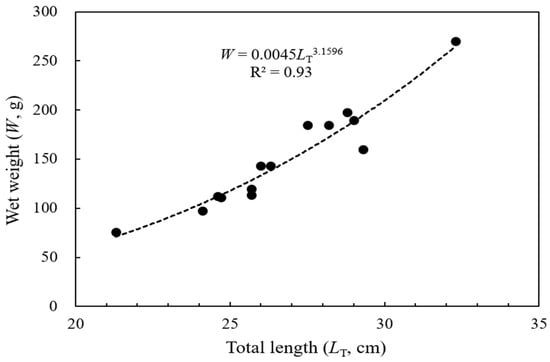
Figure 1.
The relationship between total length (LT, cm) and wet weight (W, g) in the Pacific herring used to measure TS.
Figure 2 illustrates the experimental setup and system used in the experiment. A scientific echosounder (EK60, Simrad, Kongsberg, Norway) was used to measure the TS of Pacific herring at 38 and 120 kHz (split-beam), and an underwater camera (T-water-7000DX, WIRELESS TSUKAMOTO, Suzuka, Japan) was used to observe changes in the tilt angle. A video capture card was connected to a signal generator (WF1944A, NF Electronic Instruments, Yokohama, Japan). A square wave trigger signal was created by the signal generator, the pulse interval was controlled by an external trigger (0.5 s), and the images were saved on a computer using the video capture card (VCE-Pro, ImperX, Boca Raton, FL, USA). The ping interval of the scientific echosounder was also set to 0.5 s to synchronize with the tilt angle. The fish were tethered using long, weighted monofilament lines attached to the mouth and tail (Figure 1). It is difficult to adjust the tilt angle of dead fish; thus, a weighted monofilament line was connected to the ventral portion of the body so that the herring stayed 3.5–4.0 m below the transducers.
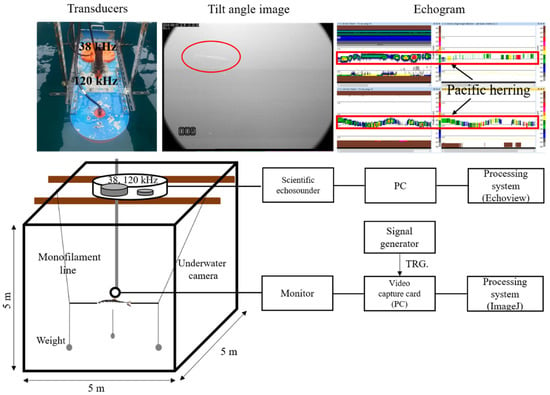
Figure 2.
Block diagram of the experimental system, and a picture of the equipment used to measure Pacific herring TS.
Before the TS measurements, the echosounders were calibrated using a standard method at 38 and 120 kHz with 60 mm and 23 mm diameter copper spheres, respectively []. The calibration results and parameter settings at 38 and 120 kHz are shown in Table 1.

Table 1.
Calibration data and parameter settings of scientific echosounder at 38 and 120 kHz.
2.3. The Theoretical Model
The Kirchhoff-ray mode (KRM) model [] was used to calculate the theoretical TS of Pacific herring. The KRM model combines the breathing mode and Kirchhoff approximation to estimate the intensity of reflected sound based on the sound speed and density contrasts among water, the fish body, and swim bladder []. This model presents the fish body and swim bladder as a fluid-filled and gas-filled cylinder, respectively. The same Pacific herring used in the ex-situ measurements were used in the KRM model. X-rays of the dorsal and ventral aspects were taken (Figure 3), and a digitizing software (GetData Graph Digitizer V 2.26; http://getdata-graph-digitizer.com, Release date: 19 June 2013) was used to separate the body and swim bladder by 0.2-mm slide spacing on the lateral and ventral sides to determine the coordinates of the body contour. The TS was calculated as reduced scattering lengths (RSL), a nondimensional, linear measurement. RSL is equivalent to the square root of the backscattering cross-section (σbs, m2) divided by the length of fish in meters []. RSL is converted to TS and length (LT) using
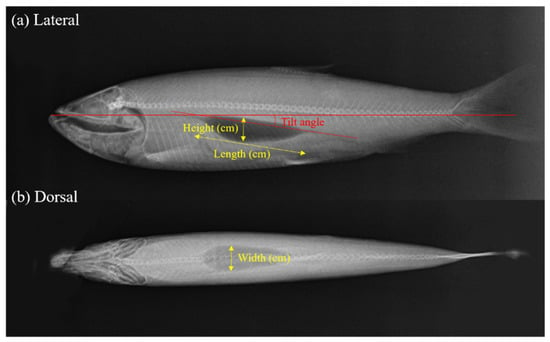
Figure 3.
X-ray image of the (a) lateral and (b) dorsal aspects of Pacific herring. The swim bladder angle (θ) is indicated as the tilt angle of the swim bladder, centerline between anterior and posterior margins, according to the fish body. The swim bladder length is indicated by the distance between the swim bladder anterior and posterior margins. The swim bladder height is indicated as the maximum thickness of the swim bladder in the lateral aspect. The swim bladder width is indicated as the maximum thickness of the swim bladder in the dorsal aspect.
Sound speed and density parameters of the fish body, swim bladder, and seawater are required for TS calculations in the KRM model. The density and sound speed of the fish body and seawater were obtained from the experiment described above (ex-situ measurements), whereas the density [] and sound speed [] of the swim bladder were obtained from previously published reports. The following values were applied to the acoustic model: body density of 1.047 g/cm3 and sound speed of 1474.6 m/s, seawater density of 1.025 g/cm3 and sound speed of 1454.1 m/s, and swim bladder density of 1.3 kg/cm3 and sound speed of 340 m/s. The TS for each tilt angle of the 14 individuals used in constructing the KRM model was calculated at 1° intervals from −90° to 90°.
2.4. Analysis of TS Data
To assess the TS–LT relationship between the ex-situ measurements and the theoretical model, a probability density function (PDF) was estimated for a mean daytime tilt angle (±standard deviation; SD) of 3.8° (±6.0°) []. The TS estimated for every 1° was transformed into a scattering cross-section, the area was multiplied by the PDF of the corresponding tilt angle, and then summed to obtain the mean TS.
where is the backscattering cross-section of each tilt angle and is the occurrence frequency of each tilt angle.
The TS–LT relationship can be expressed as Equation (5), assuming that TS is proportional to the square of the length,
where b20 indicates that the slope was fixed at 20.
3. Results
3.1. Biological Characteristics of Pacific Herring
The TS of fish is greatly affected by the size of the swim bladder; thus, the relationship between Pacific herring LT and the swim bladder equivalent radius was investigated (Figure 4). The swim bladder equivalent radius (r) is calculated as r = (length × height × width)1/3 [], where the length, height, and width refer to the dimensions of the swim bladder. The swim bladder equivalent radius increased as LT increased, but the correlation coefficient was not significant.
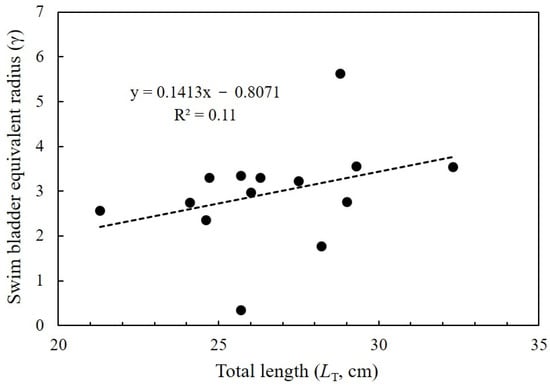
Figure 4.
The relationship between Pacific herring LT and the swim bladder equivalent radius (r).
Studies have shown that the herring swim bladder is affected by the body fat composition and gonad size [,]. The relationship between the swim bladder equivalent radius and gonad somatic index (GSI) is presented in Figure 5. GSI is calculated as GSI = gonad weight × 100/(weight–gonad weight). The swim bladder equivalent radius decreased as GSI increased, but the correlation was non-significant.
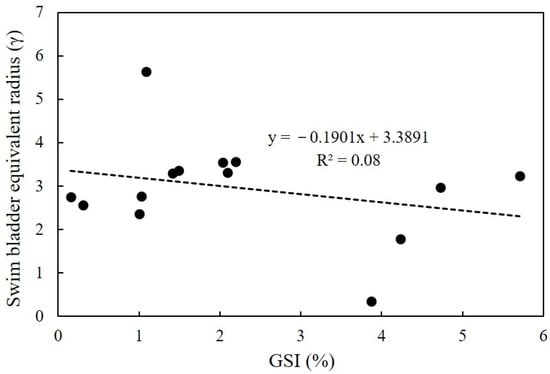
Figure 5.
The relationship between Pacific herring GSI and the swim bladder equivalent radius (r).
3.2. TS Changes with Tilt Angle
Figure 6 presents the TS results from the ex-situ measurements and the KRM model (LT: 25.7 cm, swim bladder angle: 6°) with tilt angles ranging from −60° to 60° and at two frequencies (38 and 120 kHz). When the horizontal tilt angle of the Pacific herring is 0°, a head-up orientation results in a positive (+) angle with respect to the x-axis, and a head-down orientation results in a negative (−) angle. The greatest TS values were obtained with a head-down orientation at two frequencies (38 and 120 kHz) in the ex-situ measurements and the KRM model. Higher TS values were observed with a head-down orientation because the swim bladder’s cross-sectional area becomes larger when in a horizontal position. At 38 kHz, the main TS scattering lobe showed a soft and wide boundary but narrowed as the frequency increased. There were also significant changes in the side-scattering lobe. The TS values of the ex-situ measurements and the theoretical model were comparable when the tilt angle changes were marginal but differed significantly when the tilt angle increased.
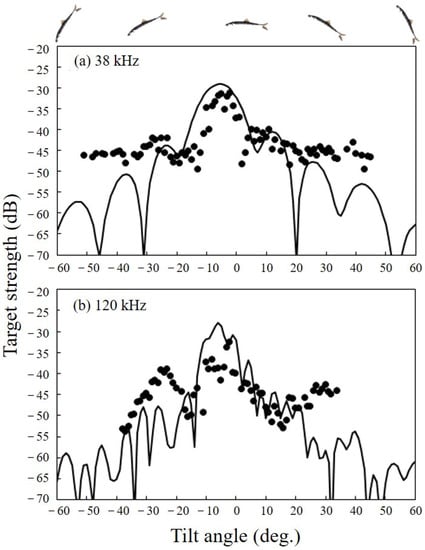
Figure 6.
The relationship between Pacific herring TS and tilt angle (LT: 25.7 cm, swim bladder angle: 6°) at three frequencies (a) 38 and (b) 120 kHz. The points represent the TS from the ex-situ measurements, and the lines represent the TS from the KRM model.
3.3. The Pacific Herring TS–LT Relationships
The TS–LT regression equations of the ex-situ measurements were (Figure 7a):
TS38kHz = 20 log10(LT) − 70.10 (95% CI: −71.78 to −68.43, r = 0.17)
TS120kHz = 20 log10(LT) − 70.59 (95% CI: −71.88 to −69.31, r = 0.10).
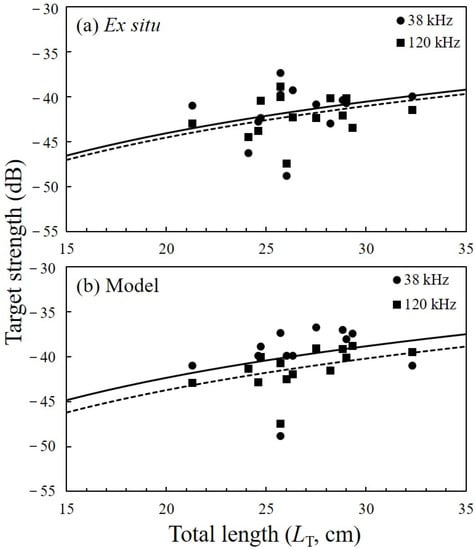
Figure 7.
The TS–LT relationships of the regression equations (20 log10(LT) + b20) at 38 (solid line) and 120 kHz (dashed line) using the (a) ex-situ and (b) theoretical model methods.
The TS–LT regression equations of the KRM model were (Figure 7b):
TS38kHz = 20 log10(LT) − 68.39 (95% CI: −70.11 to −66.66, r = 0.40)
TS120kHz =20 log10(LT) − 69.74 (95% CI: −70.88 to −68.60, r = 0.49).
4. Discussion
The TS is attributed to the swim bladder (up to 90~95% of the backscatter of the swim bladder) due to the density contrast between gas and water [,,,]. The size of the Pacific herring swim bladder varies because of differences in the fat composition, gonad size, habitat, habitat depth, and season. The Pacific herring swim bladder is likely larger in the Baltic Sea than in the Norwegian Fjords because the fat content of the Baltic herring is 2–5% (owing to the lower salinity in the Baltic), whereas the fat content of the Norwegian herring is 7–19% []. The average fat content of Pacific herring in Korean waters is 15.1% []. Pacific herring observed seasonal variation in the volume of the swim bladder, which varies depending on seasonal variations in the lipid composition, gonadal development, and stomach contents []. In this study, the swim bladder size decreased as GSI increased, but the correlation was non-significant. Samples in this study were only collected in summer, thus explaining the lack of correlation. The maximum observed GSI was approximately 6%, which is smaller than the values (14.5% (7.8–32.3%)) []. It also reported a correlation between GSI and swim bladder size [].
Pacific herring are mostly found offshore, but in late winter and early spring, they migrate to coastal areas to spawn []. Their habitats vary in depth. According to Boyle’s Law, the volume of the swim bladder decreases as the water depth and pressure increase []. A pressure change from 1 to 7 bar (equivalent to a depth range of 0–60 m) results in a decreased swim bladder volume, calculated as V = 4.20 (1 + z/10)−0.92. The dorsal cross-sectional area also decreases, calculated as A = 7.01 (1 + z/10)−0.36 []. Herring TS reported decreased herring TS as the depth increased, showing a −7 dB decrease at 100-m depth []. Herring TS relative to water depth is expressed as 20 logL–2.3 log(1 + z/10)–65.4 []. Water depth should also be incorporated into the TS estimates of Pacific herring.
The relationship between TS and the tilt angle is also important [,]. The TS range of the ex-situ measurements with variable tilt angles (−20° to 20°) was 7.7–20.2 dB at 38 kHz and 11.0–20.6 dB at 120 kHz. The mean TS was calculated at a tilt angle of 3.8° (±6.0°) for Clupea harengus: A tilt angle of 3.8° (±6.0°) was used for daytime and −3.2° (±13.6°) was used for nighttime []. Norwegian spring-spawning herring aggregate during the day; the average swimming angle is approximately horizontal, and positive swimming angles up to 40° were recorded at night []. For herring measured at 1.5- and 4-m depths: The tilt angles were –3.9° (±12.8°) and 0.2° (±11.9°), respectively []. The tilt angle of Pacific herring has not yet been reported in situ.
The b20 value estimated by ex-situ measurements and KRM model calculation were –70.10 dB and −68.39 dB at 38 kHz and −70.59 dB and −69.74 dB at 120 kHz. In this study, the b20 value was not as high as those of previous studies (Table 2). Herring has a higher fat content than other fish species. The TS of a fish with high-fat content, the orange roughy (Hoplostethus atlanticus), was measured in live and dead individuals. The TS of the dead fish was 1.9 to 9.8 dB higher than that of the live fish owing to the attached bubble and changes in the body tissues []. This study used dead fish, which could introduce post-mortem influences, including rigor mortis and denaturation of body components []. In the present study, to delay such reactions, samples were transferred to plastic bottles containing seawater and quick-frozen. However, in a few samples, the reactions might have influenced the swim bladder conditions. The TS measurements in dead Pacific herring indicated the possibility that the morphological characteristics of the swim bladder changed compared to the attached bubble.

Table 2.
Summary of target strength (TS)–length (L) relationship of this study and previous studies.
The TS–length relationship in herring has been studied (Table 2). The b20 of Pacific herring was reported to be −71.5 dB at 75 kHz [] and −64.3 dB at 120 kHz [] (Thomas et al., 2002). The b20 values at 120 kHz were higher in previous studies than in this study. The b20 of Baltic Sea herring was −70.8 to −63.9 dB at 38 kHz [,,,,,,], −69.9 dB at 70 kHz [], and −73.4 dB at 120 kHz []. The b20 of Norwegian spring-spawning herring was –73.6 dB at 18 kHz [], −71.9 and −71.1 dB at 38 kHz [,], −73.5 dB at 120 kHz [], and −73.1 dB at 200 kHz []. The herring b20 values vary because the swim bladder volumes differ across seasons and environments. Herring TS depends on the fish length, swim bladder morphology, and habitat depth.
We investigated TS of a small range of LT using dead fish. For accurate acoustic estimates of Pacific herring density, future studies will need to improve the TS vs. logLT relationship that is valid for a wide range of LT using live fish. To increase the reliability of TS results it is necessary to compare the TS of dead vs. live fish. In the present study, fish were sampled only in summer. As the GSI of Pacific herring changes by month, monthly observations of the GSI and swim bladder size are necessary. In addition, knowledge of Pacific herring ecology under their natural conditions is essential to contribute to Pacific fishery management in the future.
5. Conclusions
We reported the relationship between the TS and LT (TS = 20 log10(LT) + b20) for 14 Pacific herrings using ex-situ measurements and the KRM model at 38 and 120 kHz. The b20 values at 38 and 120 kHz were −70.10 and −70.59 dB, respectively, using ex-situ measurements, and −68.39 and −69.74 dB, respectively, using the KRM model. The difference in b20 value between ex-situ measurements and KRM model was 1.71 dB at 38 kHz and 0.85 dB at 120 kHz. The results of the present study provide basic data for future Pacific herring density and biomass estimations, which are key to evaluating the impact of their exploitation and establishing the necessary management measures.
Author Contributions
Conceptualization, E.Y. and W.-S.O.; methodology, E.Y. and W.-S.O.; software, E.Y. and H.L.; formal analysis, H.L.; investigation, E.Y. and W.-S.O.; data curation, E.Y.; writing—original draft preparation, E.Y. and H.L.; writing—review and editing, E.Y., W.-S.O., H.L., K.L., K.H. and D.-N.K.; funding acquisition, K.H. and K.L. All authors have read and agreed to the published version of the manuscript.
Funding
This research was funded by a grant from National Institute of Fisheries Science, Korea (R2021031), and a part of the project titled “Development of AI Based Smart Fisheries Management System (No. 20210499)” funded by the Ministry of Oceans and Fisheries, Korea.
Institutional Review Board Statement
The study was conducted according to the guidelines of the Declaration of Helsinki, and ap-proved by the Ethics Committee of(pro-tocol code: CNU IACUC-YS-2021-8 and 2021.10.25).
Informed Consent Statement
Not applicable.
Data Availability Statement
The authors confirm that the data supporting the findings of this study are available within the article.
Acknowledgments
This work was supported by grant from National Institute of Fisheries Science, Korea (R2021031), and a part of the project titled “Development of AI Based Smart Fisheries Management System (No. 20210499)” funded by the Ministry of Oceans and Fisheries, Korea. We are grateful to two anonymous reviewers for help improving this paper.
Conflicts of Interest
The authors declare no conflict of interest.
References
- Sugaya, T.; Sato, M.; Yokoyama, E.; Nemoto, Y.; Fujita, T.; Okouchi, H.; Hamasaki, K.; Kitada, S. Population genetic structure and variability of Pacific herring Clupea pallasii in the stocking area along the Pacific coast of northern Japan. Fish. Sci. 2008, 74, 579–588. [Google Scholar] [CrossRef]
- An, H.-C.; Kim, S.-H.; Lim, J.-H.; Bae, J.-H. Catching efficiency of the biodegradable gill net for Pacific herring (Clupea pallasii). J. Korean Soc. Fish. Technol. 2013, 49, 341–351. [Google Scholar] [CrossRef]
- Mun, S.Y.; Choi, J.H.; Lee, H.W.; Kim, J.N.; Heo, J.S.; Gwak, W.S.; Lee, Y.D. Distribution and characteristics of Pacific herring Clupea pallasii spawning beds in Jinhae Bay, Korea. Korean J. Fish. Sci. 2019, 52, 534–538. [Google Scholar]
- Sigler, M.F.; Csepp, D.J. Seasonal abundance of two important forage species in the North Pacific Ocean, Pacific herring and walleye pollock. Fish. Res. 2007, 83, 319–331. [Google Scholar] [CrossRef]
- Park, J.M.; Huh, S.H. Diel feeding activity in Summer of juvenile Pacific herring, Clupea pallasii in the Southeastern coast of Korea. Korean J. Ichthyol. 2017, 29, 267–271. [Google Scholar]
- Tomiyasu, M.; Shirakawa, H.; Iino, Y.; Miyashita, K. Tracking migration of Pacific herring Clupea pallasii in a coastal spawning ground using acoustic telemetry. Fish. Sci. 2017, 84, 79–89. [Google Scholar] [CrossRef]
- KOSIS (Korean Statistical Information Service). Statistic Database for Fisheries Production. Available online: www.kosis.kr/ (accessed on 1 March 2021).
- Ito, Y.; Yasuma, H.; Masuda, R.; Minami, K.; Matsukura, R.; Morioka, S.; Miyashita, K. Swimming angle and target strength of larval Japanese anchovy (Engraulis japonicus). Fish. Sci. 2011, 77, 161–167. [Google Scholar] [CrossRef]
- Simmonds, J.; MacLennan, D. Fisheries Acoustics Theory & Practice. Fish & Aquatic Resources Series 10, 2nd ed.; Blackwell Publication: London, UK, 2005; pp. 38–261. [Google Scholar]
- Kim, H.; Kang, D.; Cho, S.; Kim, M.; Park, J.; Kim, K. Acoustic Target Strength Measurements for Biomass Estimation of Aquaculture Fish, Redlip Mullet (Chelon haematocheilus). Appl. Sci. 2018, 8, 1536. [Google Scholar] [CrossRef]
- Sawada, K. Study on the precise estimation of the target strength of fish. Bull. Fish. Res. Agen. 2002, 11, 47–122. [Google Scholar]
- Kang, D.; Cho, S.; Lee, C.; Myoung, J.-G.; Na, J. Ex-situ target-strength measurements of Japanese anchovy (Engraulis japonicus) in the coastal Northwest Pacific. ICES J. Mar. Sci. 2009, 66, 1219–1224. [Google Scholar] [CrossRef]
- Stanton, T.K.; Chu, D. Review and recommendations for the modelling of acoustic scattering by fluid-like elongated zooplankton: Euphausiids and copepods. ICES J. Mar. Sci. 2000, 57, 793–807. [Google Scholar] [CrossRef]
- Demer, D.A.; Conti, S.G. Validation of the stochastic distorted-wave Born approximation model with broad bandwidth total target strength measurements of Antarctic krill. ICES J. Mar. Sci. 2003, 60, 625–635. [Google Scholar] [CrossRef]
- Forman, K.A.; Warren, J.D. Variability in the density and sound-speed of coastal zooplankton and nekton. ICES J. Mar. Sci. 2010, 67, 10–18. [Google Scholar] [CrossRef][Green Version]
- Smith, J.N.; Ressler, P.H.; Warren, J.D. Material properties of euphausiids and other zooplankton from the Bering Sea. J. Acoust. Soc. Am. 2010, 128, 2664–2680. [Google Scholar] [CrossRef]
- Kang, D.; Hwang, D. Ex-situ target strength of rockfish (Sebastes schlegeli) and red sea bream (Pagrus major) in the Northwest Pacific. ICES J. Mar. Sci. 2003, 60, 538–543. [Google Scholar] [CrossRef]
- Henderson, M.; Horne, J. Comparison of in situ, ex-situ, and backscatter model estimates of Pacific hake (Merluccius productus) target strength. Can. J. Fish. Aquat. Sci. 2007, 64, 1781–1794. [Google Scholar] [CrossRef]
- Foote, K.G. Fish target strengths for use in echo integrator surveys. J. Acoust. Soc. Am. 1987, 82, 981–987. [Google Scholar] [CrossRef]
- Clay, C.S.; Horne, J.K. Acoustic models of fish: The Atlantic cod (Gadus morhua). J. Acoust. Soc. Am. 1994, 96, 1661–1668. [Google Scholar] [CrossRef]
- Brawn, V.M. Buoyancy of Atlantic and Pacific Herring. J. Fish. Res. Board Can. 1969, 26, 2077–2091. [Google Scholar] [CrossRef]
- Jech, J.M.; Schael, D.M.; Clay, C.S. Application of three sound scattering models to threadfin shad (Dorosoma petenense). J. Acoust. Soc. Am. 1995, 98, 2262–2269. [Google Scholar] [CrossRef]
- Beltestad, A.K. Feeding Behavior and Vertical Migration in 0-Group Herring (Clupea harengus L.) in Relation to Light Intensity. Cand. Real. thesis. Ph.D. Thesis, University of Bergen, Bergen, Norway, 1973. [Google Scholar]
- Nakamura, T.; Hamano, A.; Abe, K.; Yasuma, H.; Miyashita, K. Acoustic scattering properties of juvenile jack mackerel Trachurus japonicus based on a scattering model and ex-situ target strength measurements. Nippon Suisan Gakkaishi 2013, 79, 345–354. [Google Scholar] [CrossRef][Green Version]
- Ona, E.; Zhao, X.; Svellingen, I.; Fosseidengen, J.E. Seasonal variation in herring target strength. Herring Expect. A New Millenn. 2001, 461, 461–487. [Google Scholar]
- Ona, E. An expanded target-strength relationship for herring. ICES J. Mar. Sci. 2003, 60, 493–499. [Google Scholar] [CrossRef]
- Mukai, T.; Iida, K. Depth dependence of target strength of live kokanee salmon in accordance with Boyle’s law. ICES J. Mar. Sci. 1996, 53, 245–248. [Google Scholar] [CrossRef]
- Kang, D.; Mukai, T.; Iida, K.; Hwang, D.; Myoung, J.-G. The influence of tilt angle on the acoustic target strength of the Japanese common squid (Todarodes pacificus). ICES J. Mar. Sci. 2005, 62, 779–789. [Google Scholar] [CrossRef]
- Lu, H.-J.; Kang, M.; Huang, H.-H.; Lai, C.-C.; Wu, L.-J. Ex-situ and in situ measurements of juvenile yellowfin tuna Thunnus albacares target strength. Fish. Sci. 2011, 77, 903–913. [Google Scholar] [CrossRef]
- Sobradillo, B.; Boyra, G.; Martinez, U.; Carrera, P.; Peña, M.; Irigoien, X. Target Strength and swimbladder morphology of Mueller’s pearlside (Maurolicus muelleri). Sci. Rep. 2019, 9, 1–14. [Google Scholar] [CrossRef]
- Didrikas, T.; Hansson, S. In situ target strength of the Baltic Sea herring and sprat. ICES J. Mar. Sci. 2004, 61, 378–382. [Google Scholar] [CrossRef]
- NIFS. Composition Table of Marine Products in Korea 2018 (8th Revision). 2018. Available online: https://www.nifs.go.kr/page?id=seafood_intro_1_01 (accessed on 20 March 2021).
- Thomas, D.L.; Kirsch, J.; Thorne, R.E. Ex-situ target strength measurements of Pacific herring and Pacific sand lance. N. Am. J. Fish. Manag. 2002, 22, 1136–1145. [Google Scholar]
- Fässler, S.M.M. Target Strength Variability in Atlantic Herring (Clupea harengus) and Its Effect on Acoustic Abundance Estimates. Ph.D. Thesis, University of St Andrews, St Andrews, Scotland, UK, 2010. [Google Scholar]
- Hazen, E.L.; Horne, J.K. A method for evaluating the effects of biological factors on fish target strength. ICES J. Mar. Sci. 2003, 60, 555–562. [Google Scholar] [CrossRef]
- Huse, I.; Ona, E. Tilt angle distribution and swimming speed of overwintering Norwegian spring spawning herring. ICES J. Mar. Sci. 1996, 53, 863–873. [Google Scholar] [CrossRef]
- Ona, E. Tilt angle measurements on herring. ICES CM 1984, 19, 7. [Google Scholar]
- McClatchie, S.; Macaulay, G.; Coombs, R.F.; Grimes, P.; Hart, A. Target strength of an oily deep-water fish, orange roughy (Hoplostethus atlanticus) I. Experiments. J. Acoust. Soc. Am. 1999, 106, 131–142. [Google Scholar] [CrossRef]
- Koseki, S.; Kitakami, S.; Kato, N.; Arai, K. Rigor mortis of fish and shellfish and evaluation of freshness of their muscles as K value. J. Sch. Mar. Sci. Technol. Tokai Univ. 2006, 4, 31–46. [Google Scholar]
- Lee, D. Fish length dependence of acoustic target strength for 12 dominant fish species caught in the Korean waters at 75 kHz. J. Korean Soc. Fish. Technol. 2005, 41, 296–305. [Google Scholar] [CrossRef]
- Lassen, H.; Stæhr, K.J. Target strength of Baltic herring and sprat measured in situ. In Proceedings of the International Council for the Exploration of the Sea, Copenhagen, Denmark, 10–13 April 1985; p. 6. [Google Scholar]
- Peltonen, H.; Balk, H. The acoustic target strength of herring (Clupea harengus L.) in the northern Baltic Sea. ICES J. Mar. Sci. 2005, 62, 803–808. [Google Scholar] [CrossRef]
- Fässler, S.M.M.; Gorska, N.; Ona, E. Differences in swimbladder volume between Baltic and Norwegian spring spawning herring: Possible consequences for mean target strength. ICES CM 2007, 3, 2005. [Google Scholar] [CrossRef]
- Kasatkina, S.M. Target strength of Baltic herring and sprat in relation to changes of their biological characteristics: Effects on acoustic abundance indices estimates. ICES CM 2007, 6, 2007. [Google Scholar]
- Kasatkina, S.M. The influence of uncertainty in target strength on abundance indices based on acoustic surveys: Examples of the Baltic Sea herring and sprat. ICES J. Mar. Sci. 2009, 66, 1404–1409. [Google Scholar] [CrossRef][Green Version]
- Schmidt, B.; Gorska, N.; Szczucka, J. Target strength relationship for herring and sprat in the southern Baltic Sea. ICES CM 2011, 15, 2011. [Google Scholar]
- Rudstam, L.; Lindem, T.; Hansson, S. Density and in situ target strength of herring and sprat: A comparison between two methods of analyzing single-beam sonar data. Fish. Res. 1988, 6, 305–315. [Google Scholar] [CrossRef]
- Foote, K.; Hansen, K.A.; Ona, E. More on the frequency dependence of target strength of mature herring. ICES CM 1993, 30, 1993. [Google Scholar]
- Misund, O.A. Target-strength estimates of schooling herring and mackerel using the comparison method. ICES J. Mar. Sci. 1996, 53, 281–284. [Google Scholar] [CrossRef][Green Version]
Publisher’s Note: MDPI stays neutral with regard to jurisdictional claims in published maps and institutional affiliations. |
© 2021 by the authors. Licensee MDPI, Basel, Switzerland. This article is an open access article distributed under the terms and conditions of the Creative Commons Attribution (CC BY) license (https://creativecommons.org/licenses/by/4.0/).